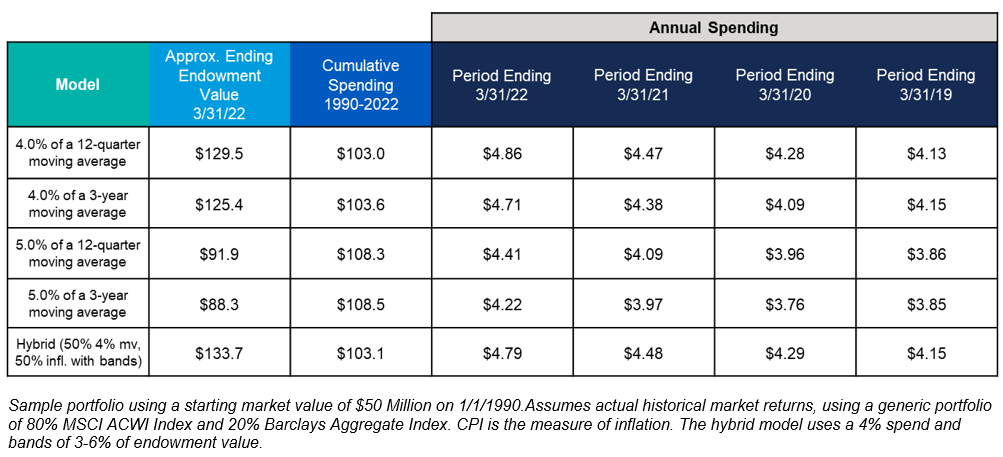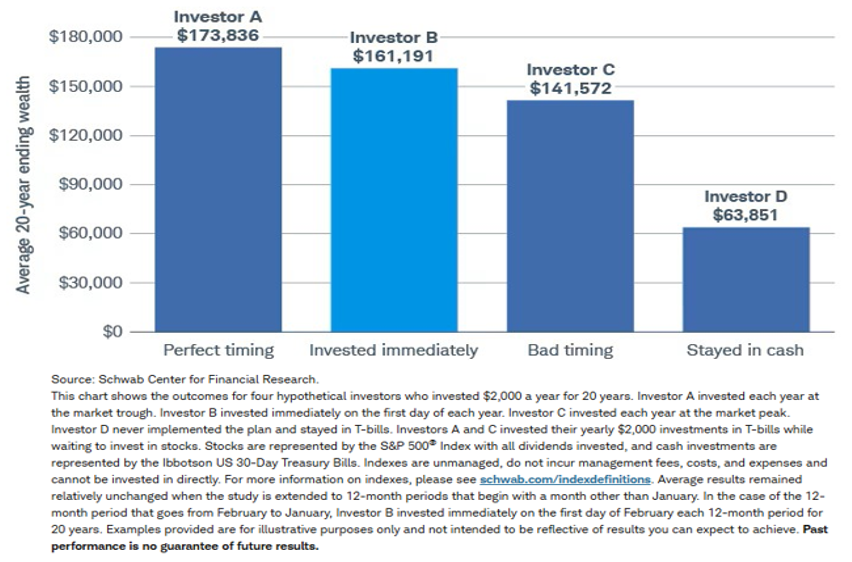A lower spending rate can lead to a greater spend allowance
As discussed in a previous blog post, “Effective Spending Policy: A ‘Ways and Means’ to Long-Term Goals,” a well-designed spending policy is essential for both advancing an organization’s mission and safeguarding the corpus of an endowment. Identifying the right spending model which aligns with the organization’s needs is crucial for long-term success and maintaining intergenerational equity. Fiducient Advisors modeled the effects of different spending strategies using relevant data points to illustrate the effect on a $50 million dollar endowment from 1990 through 2022. Ironically, as shown in the chart below, a higher preliminary spending allowance often resulted in a lower annual spending allowance over time. Why? The initial higher spending rate significantly eroded the endowment’s corpus, which means that over time, using a 5% spending allowance resulted in a progressively smaller dollar amount allocated for spending. Conversely, implementing a “lower” spending allowance of 4% would, over time, allow the endowment to have a greater annual spend allowance.

An annual review of an organization’s spending trends is a vital component of fiduciary governance. Spending practices should be regularly assessed to ensure the endowment is in alignment with guiding principles established in the Investment Policy Statement. This should include proactive planning for cash needs and avoiding unnecessary special appropriations. While we understand the challenge of reducing an existing spending rate, the long-term impact of choosing a higher spending rate could significantly reduce the corpus.
Market timing trades small profits for big risks
Market volatility may prompt committee members to take reactive measures in an attempt to “safeguard” the portfolio. However, such actions could potentially lead to missed opportunities, lower returns and harm to long-term nonprofit investors. Although market timing is widely recognized as a risky and often ineffective strategy, there are moments when the need to respond to difficult market conditions may feel unavoidable.
Charles Schwab’s research group explored five different investment strategies using a hypothetical $2,000 invested in the S&P 500 at the start of each year over a 20-year period (2003-2022)[1]. Each investor adopted a unique approach, from Peter Perfect, who perfectly timed his investments in the market on the best days of each year, to a more conservative investor like Larry Linger, who kept his funds in cash, represented by Treasury bills. The research results were surprising: despite Peter Perfect’s (Investor A) impeccable timing, his portfolio only outperformed Ashley Action (Investor B)—another hypothetical investor who simply invested the $2,000 on the first trading day of each year—by just $10,537 over 20 years.

Charles Schwab extended their research by averaging the results of 78 distinct 20-year periods for four of the five investors, excluding Matthew Monthly, a hypothetical investor who utilized a dollar-cost averaging strategy. The findings, illustrated in the graph above, showed that Peter Perfect’s strategy (represented by Investor A) led to wealth accumulation only marginally higher than that of Ashley Action (represented by Investor B), with a difference of just $12,645. More importantly, timing an investment perfectly is much easier to achieve when looking through the rearview mirror. The reality is that “perfectly” timing the market is nearly impossible. Further analysis revealed that this trend held true across different time periods. Even when considering 78 rolling 20-year periods from 1926 onward, the results remained consistent – timing the investment perfectly would not allow for a significant return. Mistimed investments carry several risks, as shown by Investor C’s strategy, who invested at the market’s peak when sentiment was at its highest—an example we will examine in the third paradox. On the other hand, there are also risks associated with inaction, as demonstrated by Investor D, who missed the opportunity to capitalize on market gains.
Ultimately, for nonprofit committees responsible for long-term investment decisions, the key takeaway is clear: staying the course and enduring market fluctuations is the most effective approach for sustaining and growing investments over time.
Market returns may be strongest when investor sentiment is weakest
A paradox exists in the cyclical nature of financial markets, where returns are often strongest when investor sentiment is weakest. While it is natural for committee members to want to retreat during times of fear and uncertainty, yielding to that sentiment can negatively affect the portfolio. Giving in to fear creates a domino effect—asset prices may fall but that may lead to reward for those willing to go against the grain. On the other hand, when excitement drives market performance, valuations and prices tend to rise, often making assets more expensive for the optimistic investor. Fear leads to sell-offs, while excitement can inflate bubbles. On average, the U.S. stock market tends to peak approximately six months2 before the economy does and tends to trough approximately five months before the end of recessions3. This inverse relationship shows us that low investor sentiment has greater correlation with the actual economy and less with the market itself. Historically, some of the best returns have come during times of widespread pessimism, with prices rebounding once sentiment improves. Recognizing that optimistic (bull) markets usually last longer than pessimistic (bear) markets can help committees maintain confidence in market outlook and broader trajectory, reducing the urge to alter asset allocations just to “safeguard” portfolios. Economic cycles of expansion and contraction are natural occurrences, and committees should embrace these fluctuations without apprehension.
The Dilemma of Extrapolating Data
It’s human nature to seek to eliminate uncertainty. We are taught that history often repeats itself, which leads us to instinctively rationalize events and draw connections between them. Extrapolation, which involves predicting an unknown value based on past events or data, is one way investors try to reduce uncertainty. Various techniques are used to forecast future trends, which can shape sentiment on market outlook. However, relying on data extrapolation for portfolio decisions without understanding its limitations can be risky, as historical data does not guarantee future returns. Identifying patterns or utilizing trends as a guide does not guarantee future outcomes, as markets can be unpredictable and sometimes irrational. So, how can investment committees navigate the future amid uncertainty? A long-term perspective and a diversified portfolio are essential strategies for nonprofits and endowments. These approaches offer the best protection against market fluctuations and help prevent hasty, reactive decisions.
Committees must recognize the importance of staying invested through all market conditions, even during periods of market volatility. Maintaining discipline, adhering to a structured strategy and reviewing asset allocations annually can help endowment and foundation investors keep their portfolios prepared for future market events without reacting to the noise.
For more information on any of the four investment paradoxes discussed within this article, please contact any of the professionals at Fiducient Advisors.
1 Charles Schwab, Does Market Timing Work? September 13, 2023
2 Russell Investments, Is the U.S. stock market looking through the recession? History has the answers, August 2020
3 Schroders, How do US stocks and earnings usually perform during recession? December 2022
The information contained herein is confidential and the dissemination or distribution to any other person without the prior approval of Fiducient Advisors is strictly prohibited. Information has been obtained from sources believed to be reliable, though not independently verified. Any forecasts are hypothetical and represent future expectations and not actual return volatilities and correlations will differ from forecasts. This report does not represent a specific investment recommendation. The opinions and analysis expressed herein are based on Fiducient Advisor research and professional experience and are expressed as of the date of this report. Please consult with your advisor, attorney and accountant, as appropriate, regarding specific advice. Past performance does not indicate future performance and there is risk of loss.


